Quaffable Holiday Dozen. The Hedonistic Wines of The Southern Rhône’s Six Mighty Crus: Hunting Ground for Bounty (4 Reds & 2 Rosés in 12-Bottle Pack $299) + A Dozen of Reds for $150
‘More bang for the buck’ or ‘more bounce to the ounce’? —choose your idiom and see how well it applies in Southern Rhône. Two factors contribute to the ocean of wild, hedonistic and affordable wines from the ground floor of French winemaking: A hot, dry Mediterranean climate that allows most grapes to fully ripen in most vintages and the generosity of the mainstay grape variety, Grenache. Given a judicious watch on acid levels, the ability of Grenache to produce big, balanced wines in copious quantities keeps prices down and makes it a quintessential quaffing wine, as perfect for a summer barbecue as it is for a hearty winter stew.
The four Southern Rhône red wines offered in this week’s package represent all the above—they are paradigms of unabashedly forward fruit that avoids becoming jammy; they are fleshy and ripe, well-structured and filled with spicy, savory undertones.
The two rosés added as a paean to springtime represent the typically Rhône-ish style of pink, richly-flavored, bone dry and somewhat darker in hue than the saccharine blush of California.
Looking Beyond Châteauneuf-du-Pape For Outstanding Southern Rhône
In Southern Rhône, Châteauneuf-du-Pape lords over the imagination. Like the Pope’s castle from which it draws its name, CdP sits atop Rhône grand pyramid—a rarified position shared (in part) by the very few villages entitled to use their own name on the label. Among these are Gigondas, Tavel, Rasteau, Cairanne, Vacqueyras, Lirac, Beaumes de Venise and Vinsobres. It is within these other bottles—the ones without the embossed papal coat of arms and St. Peter’s crossed keys—that the biggest quality bargains in Southern Rhône wine may be found.
During the 1980s (and continuing to this day), many producers in Southern Rhône found that the demand for excellent wine coupled with increasing New World competition forced a rethink of their methods. As a high yielding grape, Grenache, along with Syrah, is responsible for much of the simple bulk wines from Southern Rhône and nearby Languedoc. But to legal comply with a Cru’s exacting stipulations, yields have to be reined in. Cru is a French word meaning ‘growth’ but refers to a legally demarcated region that’s recognized for its quality and distinctive terroir. You can’t physically change your terroir, but you can streamline its expression by producing limited quantities of wine using a better selection of grapes and by using of mandated quality measures.
These ambitious improvements have supercharged the region’s sense of re-discovery, but it’s fair to say that not domains have made identical strides at the same pace. That said, the following terroirs and winemakers win our highest praise—they are wines that display phenomenal detail, rich complexity and unique personality while offering unequalled value, especially pitted against the ever-escalating price tags for Châteauneuf-du-Pape.
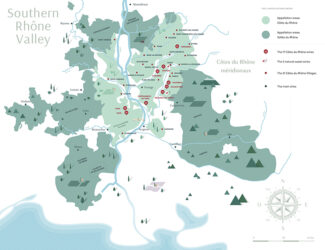
This holiday 12-bottle package is comprised of two of each of the following six wines:
Cru Gigondas: Domaine Saint Damien
In 1971, Gigondas was the first of the Côtes du Rhône Villages appellations to be elevated to Cru status. Once referred to as ‘the poor man’s Châteauneuf-du-Pape’, the fact is, Gigondas wines have improved so much that in modern times that it has become increasingly difficult to differentiate the best of Gigondas from its glossier embossed cousin. Gigondas vineyards are found along the base and slopes of the first Dentelles de Montmirail foothills, where the combination of limestone soils on the Montmirail slopes to the east, and rocky, sandy, free-draining soils on the flatter, lower-lying land to the north and west.
Spreading over 112 acres in Gigondas, Plan de Dieu and Côtes-du-Rhône Villages, Domaine Saint Damien is the brainchild of Joël Saurel and his son Romain who have lifted the estate—named for the patron saint of doctors—from humble roots to becoming one of the most reputable domains in Gigondas.
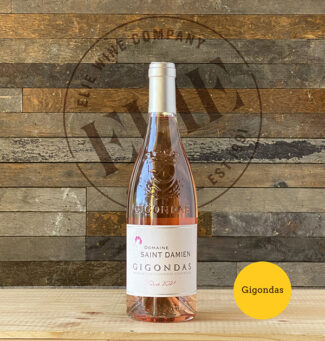 Gigondas Rosé 2021, Domaine Saint Damien ($28)
Gigondas Rosé 2021, Domaine Saint Damien ($28)
70% Cinsault, 15% Syrah, 15% Mourvèdre from vines grown in red clay dominated by ‘cailloux’ stones, all between 15 and 45 years old. The wine shows lovely sun-ripened strawberries, raspberries and loganberries along with a sweet touch of red jam. Garrigue notes develop in the glass while the fruit intensity joins the acids and powdery tannins for a luscious ride.
Cru Tavel: Château de Manissy
Tavel and rosé are inseparable terms; not only did Tavel become the first French rosé appellation in 1937, it remains the only appellation in the Rhône dedicated exclusive to producing rosé. The characteristic luminosity and complexity of Tavel rosé is in part due to the blend of allowable grapes—nine varieties, none of which makes up more than 60% of the varieties grown. Unlike much of Southern Rhône, where Grenache gets top billing, Tavel wines usually contain about half Grenache, relying on Syrah for its intense, fresh-fruit aromas, Mourvèdre for color, Carignan for tannin and Clairette—a white grape—for flowery elegance.
Located on the bank of the Rhône River opposite to Châteauneuf-du-Pape, Tavel represents a triumvirate of terroirs: The lowest portion sits on sandy soils with very little organic matter and produces aromatic, low-alcohol wines; Lauses—a type of shallow soil covered with stone tiles mixed with red clay on a limestone bedrock—results in wines of great finesse and pronounced minerality; finally, Les Vestides, where the soil is blanketed with limestone rocks and roots run deeply, produces robust, structured wines slightly higher in alcohol.
Château de Manissy was built in the middle of the 18th century by the Congregation of Missionary Fathers of the Holy Family who planted the first vines in 1916. Having developed a loyal following for their Tête de Cuvée, the priests turned over the managing of the estate to Florian André in 2004. Among the many improvements he brought to the site was a switch to minimal interference agriculture and in 2012, he certified organic and began producing some exceptional wines from the limestone and clay soils.
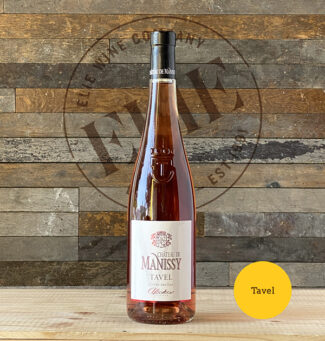 Tavel Rosé 2021, Château de Manissy ‘Cuvée des Lys’ ($16)
Tavel Rosé 2021, Château de Manissy ‘Cuvée des Lys’ ($16)
55% Grenache, 15% Syrah, 15% Clairette and 15% Cinsault, the wine shows lush summer fruit, candied raspberries and watermelon behind the flinty core. Weighty and rounded, supple, with crisp acidity and the tang of minerality.
Cru Rasteau: Domaine de Beaurenard
“Rasteau is a powerful wine,” says Helen Durand of Domaine du Trapadis. “Power and freshness aren’t opposites here. Even if acidity is soft, there is freshness from minerality and finesse, particularly with age.”
Long considered one of the best of the Côtes du Rhône Villages, the appellation obtained Cru status for dry red wines in 2010—previously, it had been heralded for its fortified sweet wine, Vin Doux Naturel. The climate is typical of Southern Rhône except that the south-facing hillsides provide protection from the cool Mistral winds; the soils are relatively diverse, though it is the higher proportion of clay which gives the red wines their distinctive body and richness.
A family-run estate for eight generations, brothers Daniel & Frédéric Coulon and Daniel’s sons Victor and Antonin carry forward Domaine de Beaurenard’s torch amid a mosaic of limestone, round pebbles on a clay substrate with varying amounts of iron and fine sedimentary sand. The brothers are nearly as well known for their cultivar conservatory as for their wine: Says Daniel, “Our primary goal was to safeguard the natural genetic heritage that is particularly well adapted to the terroir. But we were also mindful of future generations, and if global warming continues, to increase the proportion of varieties that contain less sugar and contribute aromatic complexity.”
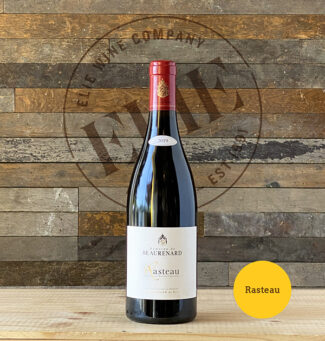 Rasteau Red 2019, Domaine de Beaurenard ($33)
Rasteau Red 2019, Domaine de Beaurenard ($33)
80% Grenache, 17% Syrah and 3% Mourvèdre from Beaurenard’s sixty acres in Rasteau, the wine displays an array of floral scents in the nose with garrigue and wild blackberry notes. Fruity and spicy on the palate with wild raspberry, rosemary and thyme with an appealing tannic structure.
Cru Vacqueyras: Domaine La Garrigue
Adjacent to Gigondas, nestling at the foot of the Dentelles de Montmirail and extending beyond the commune of Vacqueyras to Sarrians, Cru Vacqueyras was once known for the rustic quality of its wine. In recent years, however, producers have sought—and obtained—elegance to offset the brambles. The vineyards of Vacqueyras are generally found at lower elevations where it is warmer than their neighbors’ hillside sites. Many of the vines are planted in the Garrigues, or flatlands, which are covered with galets roulés, although there are a few higher-elevation vines found on the region’s sandy slopes and stony terraces. “Compared to Gigondas, Vacqueyras has always been the more accessible and eager wine,” says Jean François Arnoux of Arnoux & Fils. “It offers more fruit, warmth and spice, and it doesn’t hurt that the price is typically 20% less.”
In the world of wine, longevity is the consummation devoutly to be wished; it means staying power, both on the palate and in the field. Domaine La Garrigue was founded in 1850 by the same family that runs the property today. Brothers Maxime and Pierre Bernard are at the helm, with wives, children, nieces and nephews all at work, and there is plenty to be done: At over two hundred acres, it is the largest domain in Vacqueyras. There are three terroirs in Vacqueyras, and La Garrigue has plots in each of them, aware of what each brings to the party. Red-clay-under-galets plateau of La Garrigue (not coincidentally, where Domaine la Garrigue is located) offers power and depth, the sandy soils around the village of Vacqueyras bring finesse and the rocky limestone slopes at the foot of the Dentelles de Montmirail mean structure.
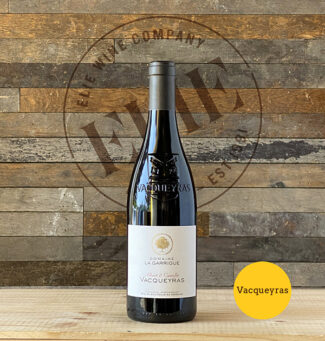 Vacqueyras Red 2019, Domaine La Garrigue ‘Albert & Camille’ ($26)
Vacqueyras Red 2019, Domaine La Garrigue ‘Albert & Camille’ ($26)
Only a thousand cases of this rich red wine were made; it is a blend of 80% Grenache with the balance being made up of Syrah and Mourvèdre from 70-year-old vines grown at an average elevation of five hundred feet. Wild raspberries and plush red plums dominate an otherwise brambly palate filled with intriguing hints of truffle, olive, peppery herb and ribbon-smooth tannins.
Cru Lirac: Domaine Maby
To say that the wines of Lirac are lyrical is not just a pun; the noted combination of elegant perfume and savory grace softens the might. Lirac’s reds are similar in style to the softest of the Côtes du Rhône Villages but miles ahead in complexity. 85% of Lirac production is red, with rosés accounting for 5% and whites the remaining 10%.
Lirac’s two thousand acres are directly across the Rhône from Châteauneuf-du-Pape, and the appellation shares the same iconic galets roulés, sand and limestone soils. Vineyards on Lirac’s upper terraces are generally made of red clay and large pebbles known as ‘terrasses villafranchiennes’; the soil of the lower vineyards shows more loess and clay-limestone. All elevations are prone to summer drought and, under certain strictures, irrigation is allowed. “The terroir of Lirac is often hidden in the shadows of Châteauneuf-du-Pape,” says Laure Poisson of Les Vignerons de Tavel & Lirac. “But in recent years, Lirac has emerged from the shadows to become something different, something unique.”
There’s no ambiguity at Domaine Maby—the Maby family has been tilling these soils for 70 years. Nestling in pastoral beauty near Avignon, the family’s first vines were in the lieu-dit Clos du Palai. In the 1960s Roger Maby snaked the holdings into the magnificent pebbled terroir of Lirac, and in 2005, Roger’s son Richard Maby—who’d spent the previous fifteen years in finance—joined the team. He recognized the potential of Lirac and Tavel and is credited with bringing new energy and a modern style to the wines.
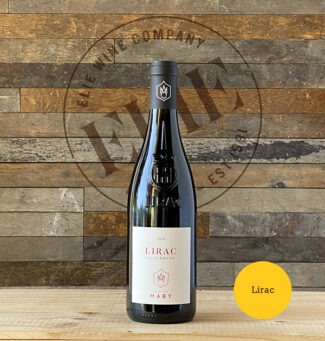 Lirac Red 2018, Domaine Maby ‘La Fermade’ ($21)
Lirac Red 2018, Domaine Maby ‘La Fermade’ ($21)
55% Grenache, 25% Syrah and 25% Mourvèdre, with the remaining five percent a field blend. ‘La Fermade’ refers to a previously-wooded plot that was cleared and replanted with Grenache, Mourvèdre, Syrah and Picpoul in the 1970s; those vines are now fully mature and produce low yields of intense fruit with balancing acidity. The wine shows a rich nose of baking spice and blackberry syrup; on the palate there is cassis, black cherry, garrigue and an undercurrent of wet stone.
Cru Cairanne: Domaine Alary
One of the Rhône’s newest and most promising appellations, Cairanne earned its Cru colors in 2016. Located just east of the historically significant city of Orange, Cairanne’s soils are predominantly made of limestone and alluvia, the latter explained by the presence of several local rivers and streams, especially the Aigues. Red, iron-rich earth over sandstone bedrocks may be also found throughout Cairanne, while topography ranges from the glacial plateau to the south of the town to the slopes of the Dentelles de Montmirail foothills to the north and west. Although 60% of the wine is the standard Grenache, Syrah and Mourvèdre blend, Syrah prefers the cooler parts of Cairanne’s mesoclimates, and in 12% of Cairanne’s blends, Syrah is the dominant varietal with Mourvèdre as the only other grape in the cépage.
Denis Alary of Domaine Alary considers himself a perfectionist as well as a grand idealist; his seventy acres of vineyard, entirely in Cairanne, is where he goes to relieve the stress that accompanies the loftiness of his ambitions. “Alone,” he says: “Without a cell phone.” As he took over the estate from his father Daniel, the oenologist is now passing responsibility to his son Jean-Etienne who brings an international reputation to this dry, dusty corner of France, having vinified at New Zealand’s Seresin, Australia’s Henschke and in France at Confuron-Cotetidot in Burgundy.
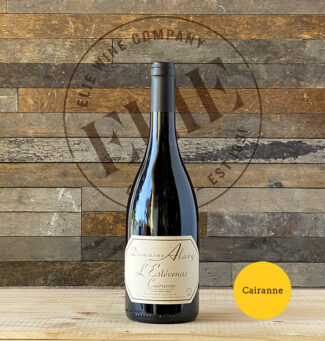 Cairanne Red 2019, Domaine Alary ‘L’Estévenas’ ($26)
Cairanne Red 2019, Domaine Alary ‘L’Estévenas’ ($26)
A 50-50 blend of Grenache and Syrah that contains one of the oldest parcels of Syrah planted in the Southern Rhône, Alary’s flagship wine delivers as expected; a focused nose with aromas of red berry, licorice and wild herbs. Inky and layered on the palate with loads of luscious black fruit alongside notes of cracked pepper, Kalamata olive and rich leather.
Buy a Dozen for $150 (Limited)
‘Cave de Cairanne’: A Grower-Owned Cooperative
In France, a wine cooperative is strength in numbers; they consist of like-minded growers and winemakers who join forces to buy grapes in bulk and vinify according to the specifics of each region from which they purchase. Thus, they serve as market regulators, due in part to the substantial volumes they handle and large storage capacities.
The Cave de Cairanne is one such endeavor. Grower-owned, it was formed in 1929 and today consists of 65 vignerons working 1300 acres in Côtes du Rhône, Côtes du Rhône Villages, Villages Plan de Dieu, Cru Cairanne and Cru Rasteau. Camille Cayran, one of the three founders, described the cooperative’s mission and pioneering philosophy in these terms: “Knowing how to understand and perpetrate the traditions handed down to us by the founding fathers of our region is the mindset of a winemaker who is also the gardener of his treasure. Deeply rooted in our history, it is also a question of respecting men all the way down the creating process from the vine to the glass. It is a veritable human adventure.”
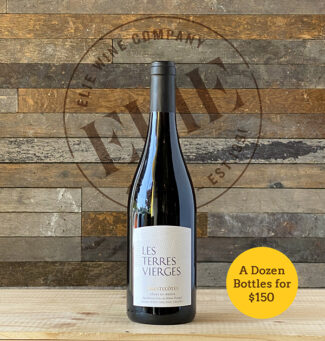 Cave de Cairanne ‘Chantecôtes – Les Terres Vierges’ Côtes du Rhône Red 2019
Cave de Cairanne ‘Chantecôtes – Les Terres Vierges’ Côtes du Rhône Red 2019
(12 Bottles Pack for $150)
Sainte Cécile Les Vignes, two years older than Cave de Cairanne, merged with that cooperative in 2020, believing that they could provide Cairanne with additional volume while upping the ante on their own quality level. “With this merger, we are giving ourselves the means to make the best possible wines, through better management of maturities, later harvests, stricter plot selections,” said Denis Guthmüller, president of Cécilia-Chantecôtes.
A balanced blend of Grenache, Syrah, Mourvèdre and Carignan, ‘Les Terres Vierges’ (The Virgin Lands) is rich crimson in color showing blackberry liqueur, ripe pie cherry, smoked meat and hints of underbrush.
- - -
Posted on 2022.05.26 in Tavel, Rasteau, Vacqueyras, Lirac, Cairanne, Châteauneuf-du-Pape, Gigondas, France, Wine-Aid Packages, Southern Rhone
Featured Wines
- Notebook: A’Boudt Town
- Saturday Sips Wines
- Saturday Sips Review Club
- The Champagne Society
- Wine-Aid Packages
Wine Regions
Grape Varieties
Aglianico, Albarino, Albarín Blanco, Albarín Tinto, Albillo, Aleatico, Arbanne, Aubun, Barbarossa, barbera, Beaune, Biancu Gentile, bourboulenc, Cabernet Franc, Cabernet Sauvignon, Caino, Caladoc, Calvi, Carcajolu-Neru, Carignan, Chablis, Chardonnay, Chasselas, Clairette, Corvina, Cot, Counoise, Erbamat, Ferrol, Fiano, Frappato, Friulano, Fromenteau, Fumin, Garnacha, Gewurztraminer, Godello, Graciano, Grenache, Grolleau, Groppello, Juan Garcia, Lambrusco, Loureira, Macabeo, Macabou, Malvasia, Malvasia Nera, Marsanne, Marselan, Marzemino, Melon de Bourgogne, Merlot, Mondeuse, Montanaccia, Montepulciano, Morescola, Morescono, Moscatell, Muscadelle, Muscat, Natural, Nero d'Avola, Parellada, Patrimonio, Petit Meslier, Petit Verdot, Pineau d'Aunis, Pinot Auxerrois, Pinot Blanc, Pinot Gris, Pinot Meunier, Pinot Noir, Poulsard, Prieto Picudo, Rondinella, Rousanne, Roussanne, Sangiovese, Sauvignon Blanc, Savignin, Semillon, Souson, Sparkling, Sumoll, Sylvaner, Syrah, Tannat, Tempranillo, Trebbiano, Trebbiano Valtenesi, Treixadura, Trousseau, Ugni Blanc, vaccarèse, Verdicchio, Vermentino, Viognier, Viura, Xarel-loWines & Events by Date
- April 2024
- March 2024
- February 2024
- January 2024
- December 2023
- November 2023
- October 2023
- September 2023
- August 2023
- July 2023
- June 2023
- May 2023
- April 2023
- March 2023
- February 2023
- January 2023
- December 2022
- November 2022
- October 2022
- September 2022
- August 2022
- July 2022
- June 2022
- May 2022
- April 2022
- March 2022
- February 2022
- January 2022
- December 2021
- November 2021
- October 2021
- September 2021
- August 2021
- July 2021
- June 2021
- May 2021
- April 2021
- March 2021
- February 2021
- January 2021
- December 2020
- November 2020
- October 2020
- September 2020
- August 2020
- July 2020
- June 2020
- May 2020
- April 2020
- March 2020
- February 2020
- January 2020
- December 2019
- November 2019
- October 2019
- September 2019
- August 2019
- July 2019
- June 2019
- May 2019
- April 2019
- March 2019
- February 2019
- January 2019
- December 2018
- November 2018
- October 2018
- September 2018
- August 2018
- July 2018
- June 2018
- May 2018
- April 2018
- March 2018
- February 2018
- January 2018
- December 2017
- November 2017
- October 2017
- September 2017
- August 2017
- July 2017
- June 2017
- May 2017
- April 2017
- March 2017
- February 2017
- January 2017
- December 2016
- November 2016
- October 2016
- September 2016
- August 2016
- July 2016
- June 2016
- May 2016
- April 2016
- March 2016
- February 2016
- January 2016
- December 2015
- November 2015
- October 2015
- September 2015
- August 2015
- July 2015
- June 2015
- May 2015
- April 2015
- March 2015
- February 2015
- January 2015
- December 2014
- November 2014
- October 2014
- September 2014
- August 2014
- July 2014
- June 2014
- April 2014
- March 2014
- February 2014
- January 2014
- December 2013
- November 2013
- October 2013
- September 2013
- August 2013
- July 2013
- June 2013
- May 2013
- April 2013
- March 2013
- February 2013
- January 2013
- December 2012
- November 2012
- October 2012
- February 2004
Search



